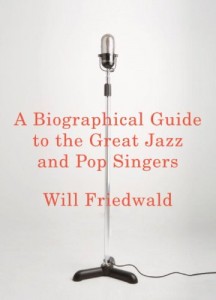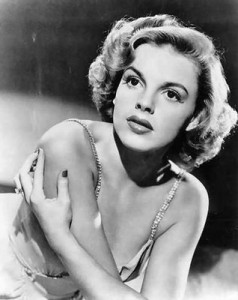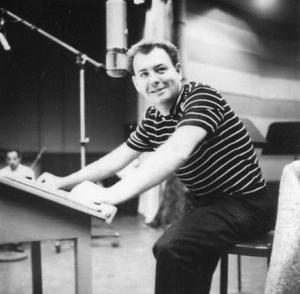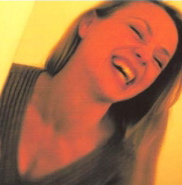Book Review: All You Want to Know about Great Jazz and Pop Singers
I never knew I needed to own a book like this, but I undoubtedly do. If there is anyone you know who loves singing and isn’t a snob about genre, this book would be a great holiday gift. It’s a colossal achievement that is also marvelously idiosyncratic.
A Biographical Guide to the Great Jazz and Pop Singers by Will Friedwald. Pantheon, 832 pages, SRP: $45 ($29.70 via amazon.com; $31.43 via target.com; $32.62 via bn.com; $45 via borders.com and powells.com; also available through many other sites)
By Steve Elman
In the great human hive, there are worker bees who embrace mental tasks that none of us other bees want. They get satisfaction from acquiring comprehensive and detailed knowledge in disciplines that may be incomprehensible to the rest of us, and sometimes they put that knowledge into a form the rest of us can actually use. Glory be to God for diligent discographers, catalogers of complete oeuvres, weighers of atomic particles, compilers of census data, creators of fan websites, and the people who sort the screws into those tiny plastic drawers in all the world’s hardware stores.
But among these glorious obsessives, there are only a tiny handful who can also make great conversation at cocktail parties. I’m willing to bet that Will Friedwald is a member of this super-elite.
Friedwald’s new book, A Biographical Guide to the Great Jazz and Pop Singers, is packed with valuable information, stuffed with informed opinion, larded with bon mots and clever turns of phrase, and seasoned with just the right number of zingers. I never knew I needed to own a book like this, but I undoubtedly do. If there is anyone you know who loves singing and isn’t a snob about genre, this book would be a great holiday gift.
Let me try to mirror the structure of many of Friedwald’s essays by giving you a global assessment, a catalog of particular delights, and a snappy finish. (You’re going to see a lot of quotes; when writing is this good, all you want to do is repeat it.)
Friedwald has ordered a series of beautifully-crafted essays on singers into an alphabetical encyclopedia of leading lights (536 pages of two-column text) followed by a quirky appendix of lesser singers grouped into various categories (233 pages, a book unto itself) and a 29-page afterword of five essays appreciating masters of non-jazz forms. He’s been working on it for 10 years, with major revisions occupying 2008 through 2010. It’s a colossal achievement that is also marvelously idiosyncratic.
Friedwald defines his subjects as “artists who made a vital contribution to the way the [American] songbook is sung,” with a jazz bias, “to a degree. . . [including] all the major jazz singers and as many pop singers as there was room for.” Fred Astaire is essayed; Gene Kelly is not. Judy Garland is essayed; Liza Minnelli is not. Ray Charles is essayed; Stevie Wonder and Dr. John are not.
A case could be made to Friedwald that he might have included essays on Bob Dorough, Leon Thomas, and Leo Watson, but perhaps they are not “major” enough jazz singers. He might have included Solomon Burke, Mary Ford, and James Brown, just to name three significant pop singers, but there must not have been room for them.
The ins and outs don’t matter, though. This material has deep, personal resonance for the author, and he delivers his appreciations of singers and his pronouncements about their work with such from-the-heart verve that he redefines the very idea of the music encyclopedia. After all, no writer is unbiased; why not make the biases explicit and entertaining?
I have not read the entire book, but I’ve spent several weeks with it, and I look forward to reading every word, because Friedwald is a master of contemporary prose. Every essay I’ve gotten through has a great, attention-getting lead, a cogent critical summary of the singer’s work and importance, a roughly chronological bio, a survey of important recordings, and a pithy wrap up. Sustaining this structure over such a long arc of development must have been enervating, but Friedwald never seems to flag.
Perhaps the best way to give you a flavor of the book is to quote some of the best quips: “The word ‘subtlety’ isn’t subtle enough to describe” Chris Connor. Nat King Cole’s was “the art of the artless.” “[Frank] Sinatra made you feel like you could go out and conquer the world; [Perry] Como made you feel like you didn’t have to do anything.” Louis Prima was part of “an entire generation of trumpeter-singers . . . who learned to play through the process of Satchmosis.” Vera Lynn’s “major contribution to music would seem to be bringing monotony to a whole new level.”
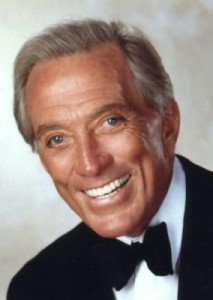
Andy Williams. He perfected the art of singing songs in such a way that you don’t actually have to listen to him.
Andy Williams “perfected the art of singing songs in such a way that you don’t actually have to listen to him.” Abbey Lincoln’s sense of rhythm was “engagingly lumpy.” Sammy Davis, Jr.’s second recorded version of “That Old Black Magic” “seems like Tourette’s Syndrome set to music.” “By the millennium, the principal difference between a jazz singer and a cabaret singer was that the latter talked considerably more and always thanked the lights-and-sound guy.” Connie Boswell is compared to Mildred Bailey: “a petite femme with a deep throaty sound as opposed to a plus-sized gal with teensy girlish pipes.” And beware “the dread Andrew Lloyd Webber.”
This engaging style is put to use giving us the basics, plus plenty of notable revelations and interesting insights: Cliff Edwards was a godfather of scat singing. The multi-tracking in Patti Page’s most popular recordings both distinguished her work and disguised her real gifts as a singer. Sheila Jordan has won the award for talent deserving of wider recognition in the Down Beat poll nine times, “a record for a vocalist.” Abbey Lincoln made a notable appearance on Oscar Levant’s television show. Rudy Vallee bragged about the “cock in my voice.”
Friedwald is so confident of his craft that he is unafraid to put slang to work in the midst of serious observations: Cliff Edwards “died all but forgotten in a home for aged actor dudes.” “Vallee’s ’My Dancing Lady’ just plain kicks.” Ella Fitzgerald’s Pablo LP covers “inevitably portray her as hamish as possible.”
Here he applies a more serious tone, at somewhat greater length:
“There’s a part of the American psyche that likes to reach instantly for the negative. Mention Frank Sinatra and they’ll tell you what a horrible person he was. Mention Bing Crosby and they’ll tell you he beat his kids (again a grotesque exaggeration and distortion of the truth). Mention either Judy Garland or Billie Holiday and their artistry will be ignored while you’re told that they were both self-destructive, self-medicating nut jobs. Somehow pointing out the flaws, real or imagined, of these larger-than-life icons makes people feel better about themselves.”
“I doubt that there’s anyone reading this who has spent more time listening to [June] Christy than I have . . . I confess that all my intense concentration has come to naught. Asked to explain why she’s so good . . . I still can’t provide an easy answer . . . her artistry can’t be summed up in a sound bite.”
That last admission is almost unique in the book. One of Friedwald’s greatest accomplishments is that he tells you why he admires the singers he admires and why he faults the singers he faults. There are few adjectives or adverbs that aren’t backed up by examples on disc, precise descriptions of technique, or insightful analysis of repertoire.
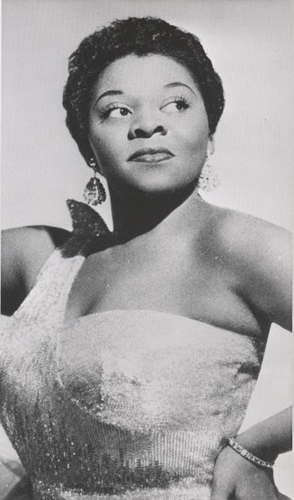
Dinah Washington. When Friedwald discusses her 21-CD retrospective on Mercury, there’s no doubt that he listened to every note.
He is also admirably color-blind. There has been for decades a kind of reverse racism in assessing the work of jazz musicians, and especially of jazz-oriented singers—it was thought that Crosby, the Boswells, Mildred Bailey, etc., could never stand comparison to Armstrong, Ella, Billie Holiday, etc. as innovators or artists. White performers weren’t just the second line; Albert Murray memorably summed them up as the “third line.” Friedland just sweeps all the racial issues aside. Every singer is assessed on his or her own standards of craft, and credit is given where credit is due. His household gods are Louis, Frank, Ella, Nat, Bing, and Billie, and the essays on each of them are among the best assessments I’ve ever read in such short spaces. Others don’t merit full deification, but that’s only just.
His attention to detail is daunting. He knows track after track, album after album, and, for the most part, it seems that he did not do his listening just for the purpose of this book—he seems to know thousands of recordings intimately and tens of thousands in passing. For example, when he discusses the 21-CD, Dinah Washington retrospective on Mercury, there’s no doubt that he listened to every note.
He also betrays pique when others don’t come up to his standard (“The notes for the 2002 BMG reissue [of Della Reese’s Special Delivery] are irritating in that they insist that this is her first album; it’s actually her seventh—can’t BMG afford a discography?”). This perspective leads to some unintentional humor as, when discussing the nearly-forgotten Marion Harris, he says, “I can’t claim to be familiar with every major artist of the acoustic era.” Easy, Will, we can accept that you’re human.
In a project of this size, there are inevitably places where intelligent listeners will cross swords with Friedwald. Well, let this fool rush in with a point close to the heart of the book’s raison d’etre: I wondered why he never exactly described the who and how of the Boswell Sisters’s groundbreaking vocal arrangements—were they joint creations, or the work of individual sisters, or the inspiration of others behind the scenes?
A little farther from the center, I was a bit surprised at his enthusiasm for Nelson Riddle as an arranger and orchestrator. For example, in discussing Ella Fitzgerald’s Gershwin songbook project, he says, “There was no one [arranger] who could have more effectively kept the proceedings from getting too overdone or bombastic than Riddle.” Really? Not Gil Evans or Gary McFarland or Quincy Jones? To me, Riddle is too often guilty of just these faults.
An outside point but significant to me is that in the essay on Andy Bey, he describes Gary Bartz as “one of the best saxists of our time.” Is Bartz really on par with Rollins, Ornette, Branford Marsalis, Archie Shepp, Paquito D’Rivera, Jane Ira Bloom, and Miguel Zenon? Maybe this enthusiasm could have been dialed back a bit.
I’m on firmer ground when I say that Pantheon should have given this book the index that it so richly deserves. The alphabetical table of contents is useful, but it’s not enough, not by a long shot.
Many singers are referred to outside of their essays, as influences on others or as figures of contrast with other singers. Many instrumentalists are discussed, sometimes more than in passing. And there are hundreds of other figures in popular culture who add color and interest. Not to have them indexed is a great injustice to Friedwald’s work.
For example, in the three-and-a-half page essay on Hadda Brooks, a pianist-singer who worked in instrumental and vocal boogie-woogie, vocal blues, and classic popular songs, there is a paragraph-long aside on boogie pianist Hazel Scott, a one-sentence appreciation of Jack Sheldon (who sang occasionally when not playing trumpet), and mentions of more than 70 other people, including Charles Brown, Fats Waller, Franz von Suppé, Memphis Minnie, Turhan Bey, Adam Clayton Powell Jr., Charles Mingus, Oprah Winfrey, Irving Berlin, Gloria Grahame, Thelonious Monk, Etta James, Vaughn Monroe, Sean Penn, and Spike the Wonder Mule (OK, Spike wasn’t a person, but still . . .).
Ancillary figures who are important in the consideration of American popular music are treated comprehensively but in piecemeal fashion—Mitch Miller is alternately pop’s “mixmeister supreme,” a schlockfaber, a hitmaker, and a Svengali. He was the guiding genius behind the careers of Frankie Laine, Guy Mitchell, and Johnny Ray, for whom Friedwald has little sympathy; still, the fact that he produced recordings by Lee Wiley and appreciated her talent proves that he wasn’t pure evil. But you can’t get the complete Friedwald picture of Miller’s work without an index listing.
If you want to catalog the work of great arrangers or find compliments paid to singers who did not rate essays, you are on your own. For example, Boston’s own Dominique Eade gets a well-deserved nod in the essay on Chris Connor.
Even more crucially, the book needs a song index. Thousands of songs are mentioned, including standards and oddities and everything in between; for this fact alone, it could be a very useful resource for song research, but it isn’t so yet. For example again, in the Hadda Brooks essay, more than 45 different songs are mentioned, from “Chopin’s Polonaise Boogie” to “I Hadn’t Anyone Till You” to “You’re My Cadillac.”
An index might also try to encompass some topics that are mentioned in passing within essays—for example, Friedwald’s remarks on the fad for songs romanticizing the South (“Mammy and Swanee songs”) in the essay on the Boswell Sisters (on page 53, if you’d like to read it).
These problems could be remedied promptly with an on-line index, and if the book goes to more printings, it could be corrected in future editions. Speaking of which, Friedwald hopes to bring out new versions of this book every six or seven years. I hope he does so, and I hope that future editions get indexes.
Here are some other suggestions for the next one and its successors: There is a strong sense of genealogy in the book—of singers begetting other singers stylistically; a schematic chart putting this in visual form would be valuable. And the biographical material or a just-the-facts edit thereof might be placed at the head of each essay in distinguishing typeface, which would make things more useful to someone consulting the book for facts.
Here’s the big finish, as promised: With his 1996 book Jazz Singing, his bio of Sinatra, his book on America’s most popular songs (Stardust Melodies), and his extensive track record as a writer for periodicals and newspapers, Friedwald has defined a musical territory and made a very good case that he is its chief chronicler. With this book, he proves that he owns it outright.
Steve Elman’s four decades (and counting) in New England public radio have included ten years as a jazz host in the 1970s, five years as a classical host in the 1980s, a short stint as senior producer of an arts magazine, thirteen years as assistant general manager of WBUR, and currently, on-call status as fill-in classical host on 99.5 WCRB since 2011. He was jazz and popular music editor of The Schwann Record and Tape Guides from 1973 to 1978 and wrote free-lance music and travel pieces for The Boston Globe and The Boston Phoenix from 1988 through 1991.
Tagged: A Biographical Guide to the Great Jazz and Pop Singers, Jazz, Steve Elman, music history, new-york-times, vocals

